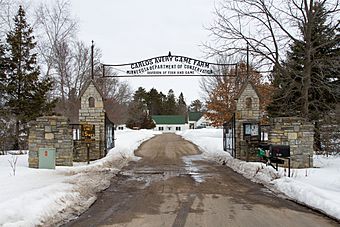Carlos Avery Game Farm facts for kids
Quick facts for kids |
|
|
Carlos Avery Game Farm
|
|
 |
|
| Lua error in Module:Location_map at line 420: attempt to index field 'wikibase' (a nil value). | |
| Location | Linwood Township, Anoka County, Minnesota |
|---|---|
| Nearest city | Columbus, Minnesota |
| Area | 16 acres (6.5 ha) |
| Built | 1936 |
| Built by | Works Progress Administration |
| Architect | Walter D MacLeith |
| Architectural style | Colonial Revival |
| MPS | Federal Relief Construction in Minnesota MPS |
| NRHP reference No. | 91000977 |
| Added to NRHP | August 9, 1991 |
The Carlos Avery Game Farm is a group of 11 historic buildings in Minnesota, United States. These buildings are part of the larger Carlos Avery State Wildlife Management Area. This special area is listed on the National Register of Historic Places, which means it's recognized for its important history.
The buildings serve as the main office for the huge wildlife management area. This area covers large parts of Anoka and Chisago counties. It also helps manage other natural resource properties nearby. When the game farm opened in 1937, it was one of the biggest and best-equipped wildlife farms in the country. It was also one of the first major efforts in Minnesota to help wild animals.
Contents
Who Was Carlos Avery?
The wildlife refuge is named after Carlos Avery (1868-1930). He was a key leader for the Minnesota Game and Fish Commission. He worked there from 1907 to 1909 and again from 1915 to 1923.
How the Land Was Acquired
The land for the refuge was first bought from the Crex Carpet Company. This company used to harvest a special type of grass from the land to make rugs. In 1933, the land was taken back by the state because taxes weren't paid. Then, the Minnesota Conservation Commission bought it. The Carlos Avery Game Farm officially opened and was named after Carlos Avery in 1938.
Helping Wildlife and People
The land was perfect for raising bobwhite quail. These birds used to be common in Minnesota but were starting to disappear. In 1935, the United States government asked states to suggest projects. These projects aimed to help people find jobs during a difficult economic time.
The Works Progress Administration
The game refuge project was approved by the Works Progress Administration (WPA). The WPA was a government program created by President Franklin D. Roosevelt. It helped put many Americans to work. The refuge was built with five main buildings. These included a central heating plant, a pump house, two houses, a barn/henhouse, and an incubation room. The refuge also had a safe area for wild birds and animals, a plant nursery, and places for public hunting.
Raising and Protecting Animals
The project to raise bobwhite quail started with 200 pairs of birds. These birds were brought from another game farm in Mound, Minnesota. The first breeding season produced 1,879 birds. About 1,000 of them were kept for future breeding, and the rest were released into the wild. The bobwhite quail project continued until 1955.
Other Animal Programs
The refuge also raised other types of birds:
- Chukar partridge from 1939 to 1947.
- Ring-necked pheasants from 1947 to 1981.
- They also helped bring back the Canada goose from 1950 to 1970.
A New Approach to Wildlife Management
In 1981, the way the refuge was managed changed. The Minnesota Department of Natural Resources stopped large-scale breeding programs. Instead, they focused on making the natural homes (habitats) better for animals. This included providing good places for nesting and plenty of food.
As of 2009, the wildlife management area has a 4,500-acre sanctuary. This area is closed to all hunting and trespassing. Outside the sanctuary, people can enjoy hunting for waterfowl, deer, and squirrels. Trapping for mink, muskrats, raccoons, and beavers is also allowed. More than 272 different kinds of birds visit the refuge. This makes it a very popular spot for bird watching.


